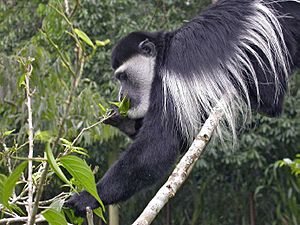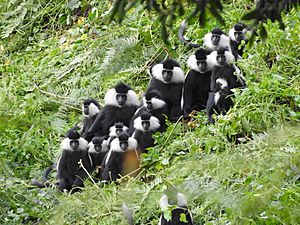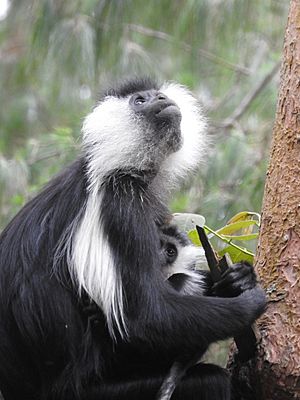Black-and-white colobus facts for kids
Quick facts for kids Black-and-white colobus |
|
|---|---|
 |
|
| Mantled guereza (Colobus guereza) | |
| Scientific classification |
|
| Kingdom: | Animalia |
| Phylum: | Chordata |
| Class: | Mammalia |
| Order: | Primates |
| Suborder: | Haplorhini |
| Infraorder: | Simiiformes |
| Family: | Cercopithecidae |
| Subfamily: | Colobinae |
| Genus: | Colobus Illiger, 1811 |
| Type species | |
| Simia polycomos Schreber, 1800
(Cebus polykomos Zimmermann, 1780) |
|
| Species | |
|
Colobus satanas |
|
Black-and-white colobuses are a type of monkey found in Africa. They are also known as colobi. These monkeys belong to the Colobus genus. They are closely related to the red colobus monkeys. There are five main species of black-and-white colobuses. Scientists have also found at least eight different subspecies.
You can usually find these monkeys in thick forests. They search for food there, mostly eating leaves, flowers, and fruit. Colobus monkeys live in social groups. These groups can be very different from one another. Female colobuses often help care for each other's babies. This is called allomothering. These monkeys also show interesting behaviors. They have special ways of greeting each other. Their sleeping patterns also change depending on the group. Colobus monkeys are important for spreading seeds in their habitats.
Contents
What's in a Name?
The name "colobus" comes from an old Greek word. That word is kolobós. It means "docked" or "maimed." This name was given to them because their thumbs are very small. They look like a stump.
Types of Colobus Monkeys
There are several species and subspecies of colobus monkeys. Here are the main ones:
- Genus Colobus
- Black colobus, C. satanas
- Gabon black colobus, C. s. anthracinus
- Bioko black colobus, C. s. satanas
- Angola colobus, C. angolensis
- Sclater's Angola colobus, C. a. angolensis
- Powell-Cotton's Angola colobus, C. a. cottoni
- Adolf Friedrichs's Angola colobus, or Ruwenzori black-and-white colobus, C. a. ruwenzorii
- Cordier's Angola colobus, C. a. cordieri
- Prigogine's Angola colobus, C. a. prigoginei
- Peters's Angola colobus or Tanzanian black-and-white colobus, C. a. palliatus
- King colobus, C. polykomos
- Ursine colobus, C. vellerosus
- Mantled guereza or Abyssinian black-and-white colobus, C. guereza
- Black colobus, C. satanas
How Colobus Monkeys Live
Colobus monkeys live in many types of forests. This includes untouched forests and those that have been logged. They also live near rivers and in grassy woodlands. They are often found in forests where many trees have been cut down.
What Colobus Monkeys Eat
Colobuses have a special digestive system. It is similar to that of a cow. This helps them eat foods that other monkeys cannot. They are herbivores, meaning they only eat plants. Their diet includes leaves, fruits, flowers, and tree bark. They also eat lichen and other plants.
Colobus monkeys are important for spreading seeds. When they eat, they can be a bit messy. Also, seeds pass through their digestive system. This helps new plants grow in different areas. The toughness of leaves affects how well they can eat. Tougher leaves take more chewing. Colobus monkeys spend about 150 minutes eating each day. In mountain areas, they eat lichen when other foods are scarce.
Social Life and Appearance
Colobus monkeys live in groups. These groups protect their territory. The size of a group can vary, from 3 to 15 monkeys. Scientists first thought groups had one male and about eight females. But now we know groups can have many males and females. Some groups can even be very large, with over 500 monkeys!
There is usually one dominant male in a group. But females in the group seem to be equal. They don't compete much with each other. Younger monkeys have a lower rank than older ones. Colobus monkeys do not have a specific breeding season.
Adult colobuses are mostly black. They have white fur around their faces. A long "U" shape of white fur runs along their sides. Baby colobuses are born completely white. Their faces are pink. Other monkeys in the group often help care for the babies. This is called allomothering. It might help the helper monkey's family. It could also help them practice for their own future babies.
Monkey Manners and Sleeping Habits
Colobus monkeys have special ways of greeting each other. When they meet familiar monkeys, they perform a greeting ritual. This helps them show they are still friends. The monkey that approaches usually starts the greeting. Often, they will groom each other afterward.
They have three types of physical greetings. These include mounting, head mounting (holding shoulders), and embracing. These actions do not seem to be related to mating.
Black-and-white colobuses have interesting sleeping habits. They sleep in trees close to their food source. This helps them save energy. Groups often change their sleeping spots. This might help reduce parasites. It also makes it harder for predators to predict where they will be. They tend to sleep closer together on clear nights. They sleep in the middle or upper parts of tall trees. This allows them to watch for predators. It also protects them from animals on the ground and in the air. They don't seem to prefer a certain type of tree. But they are often seen sleeping in Antiaris toxicaria trees.
Protecting Colobus Monkeys
Colobus monkeys face many dangers. They are hunted by many animals in the forest. People also hunt them for bushmeat. This is meat from wild animals. Their homes are also destroyed by logging and other human activities.
Colobus monkeys are more watchful when they are in areas with less tree cover. They also spend less time looking for threats when they are with their own group. There isn't a big difference in how watchful males and females are. However, males tend to be more watchful during mating season.
See also
 In Spanish: Colobos para niños
In Spanish: Colobos para niños




